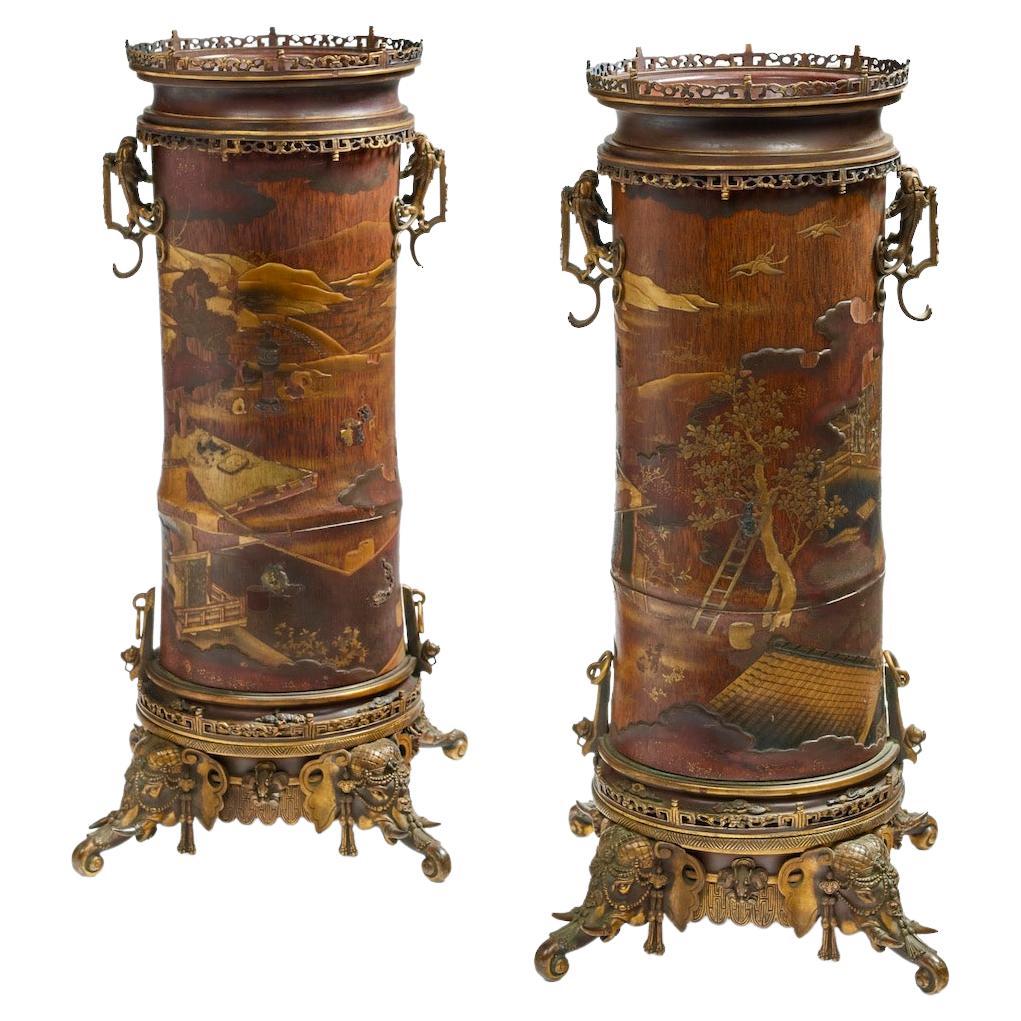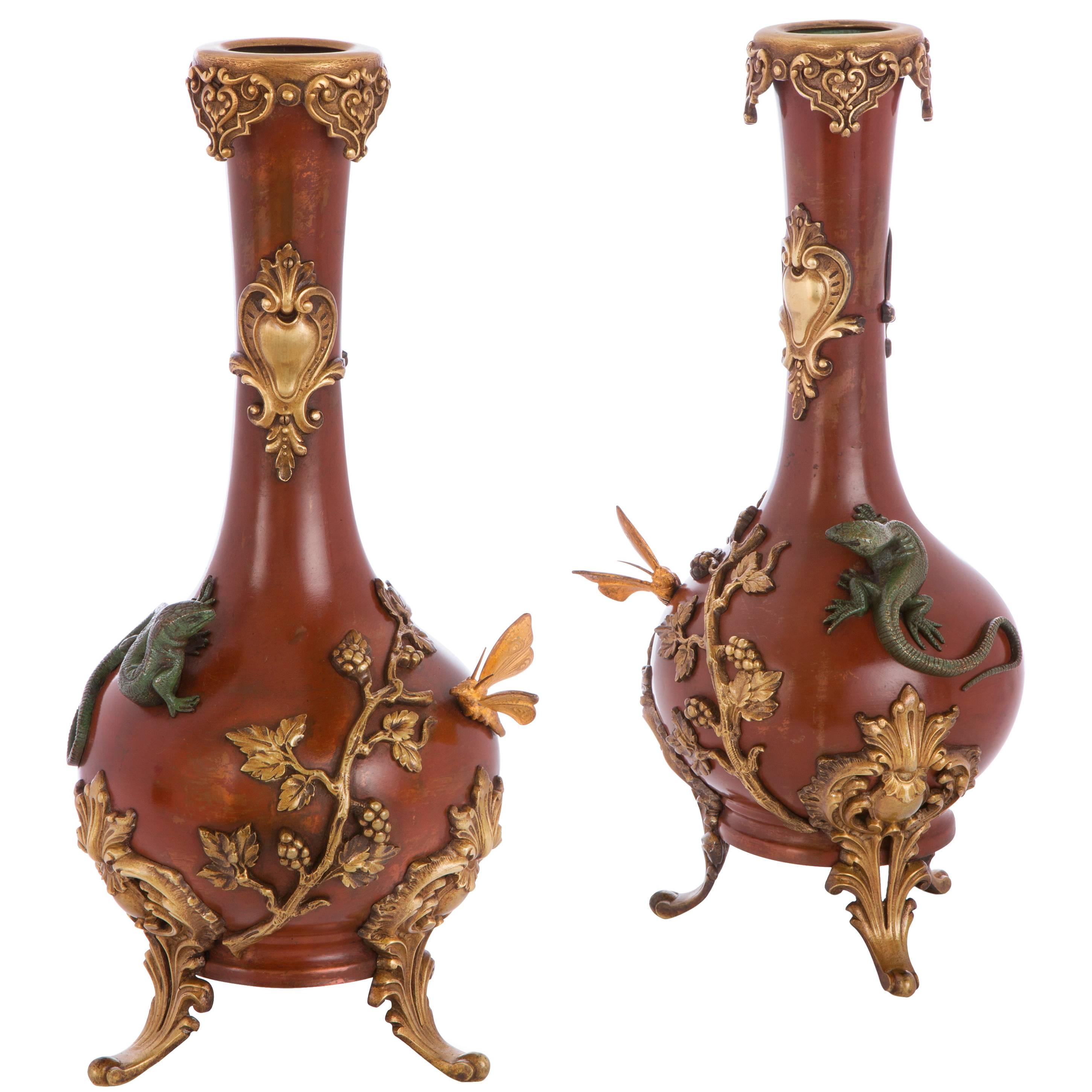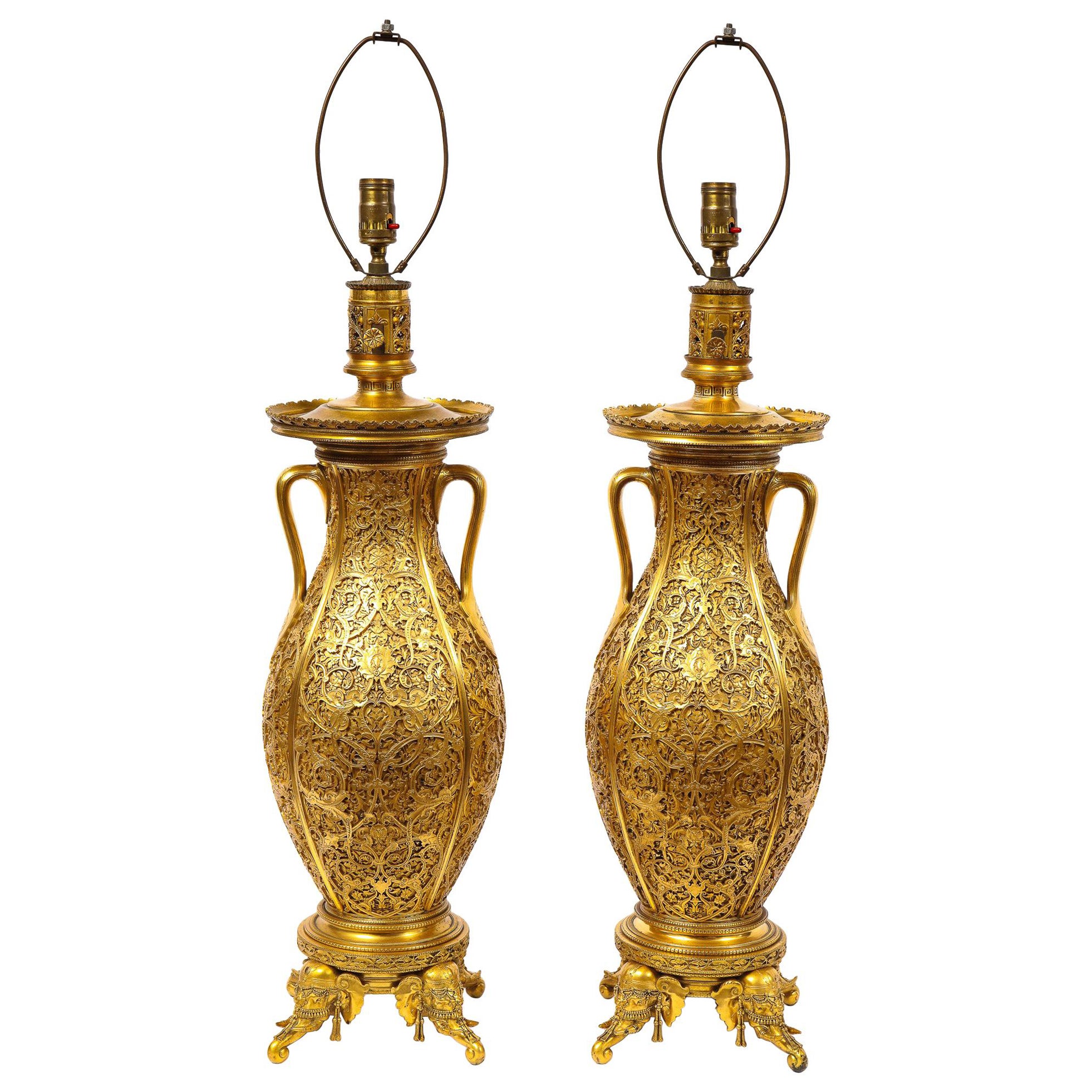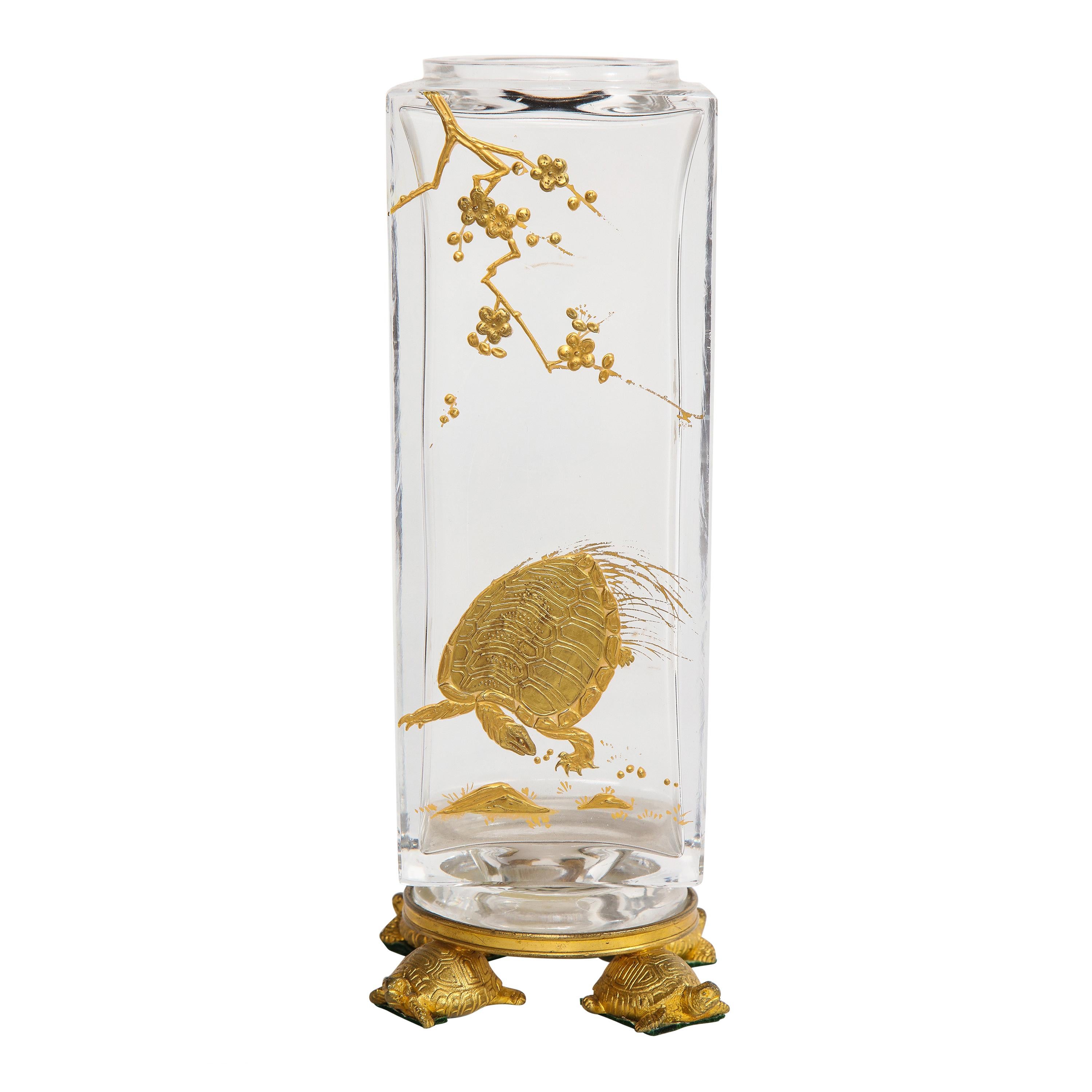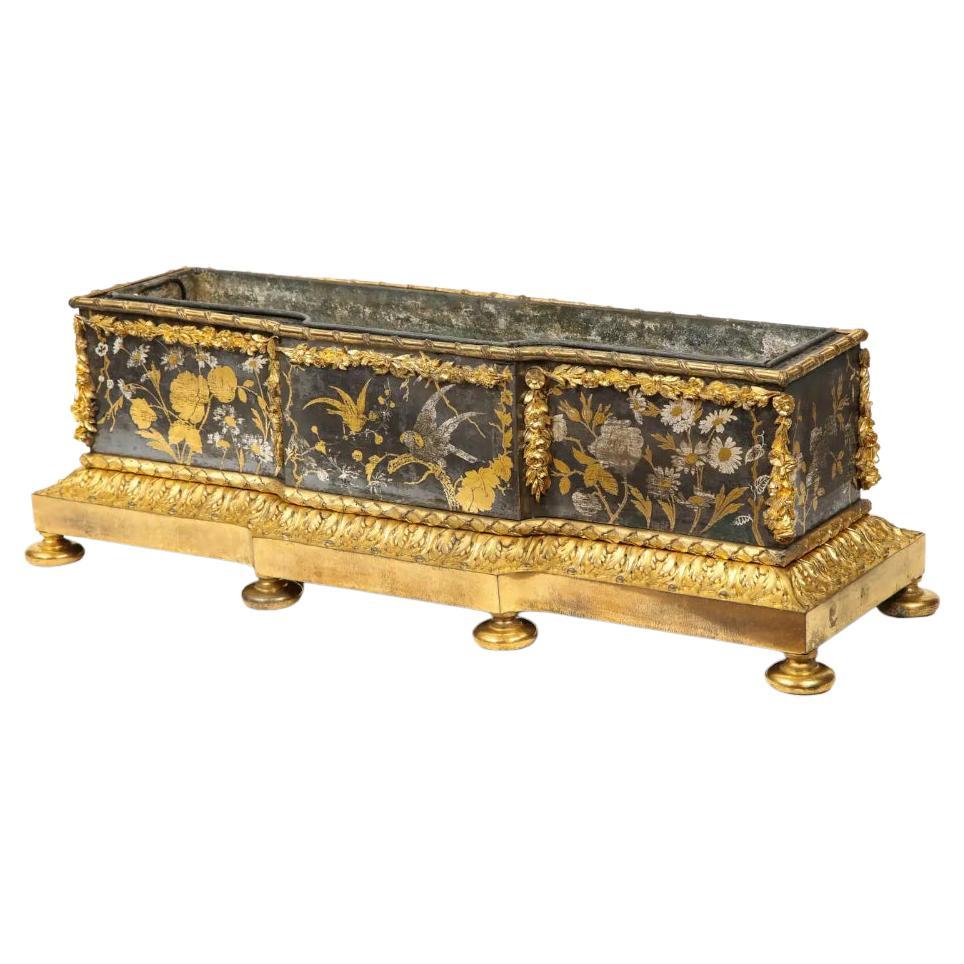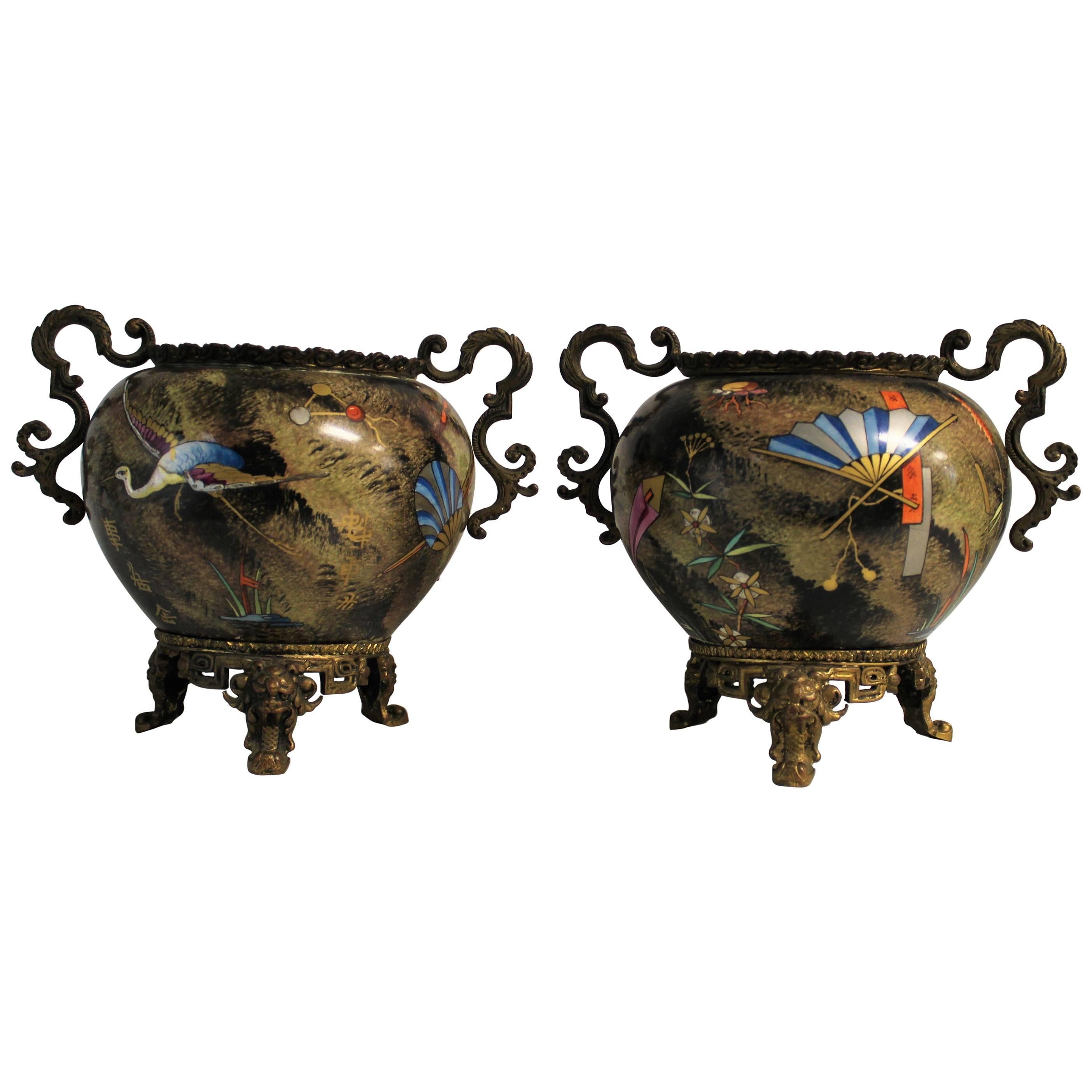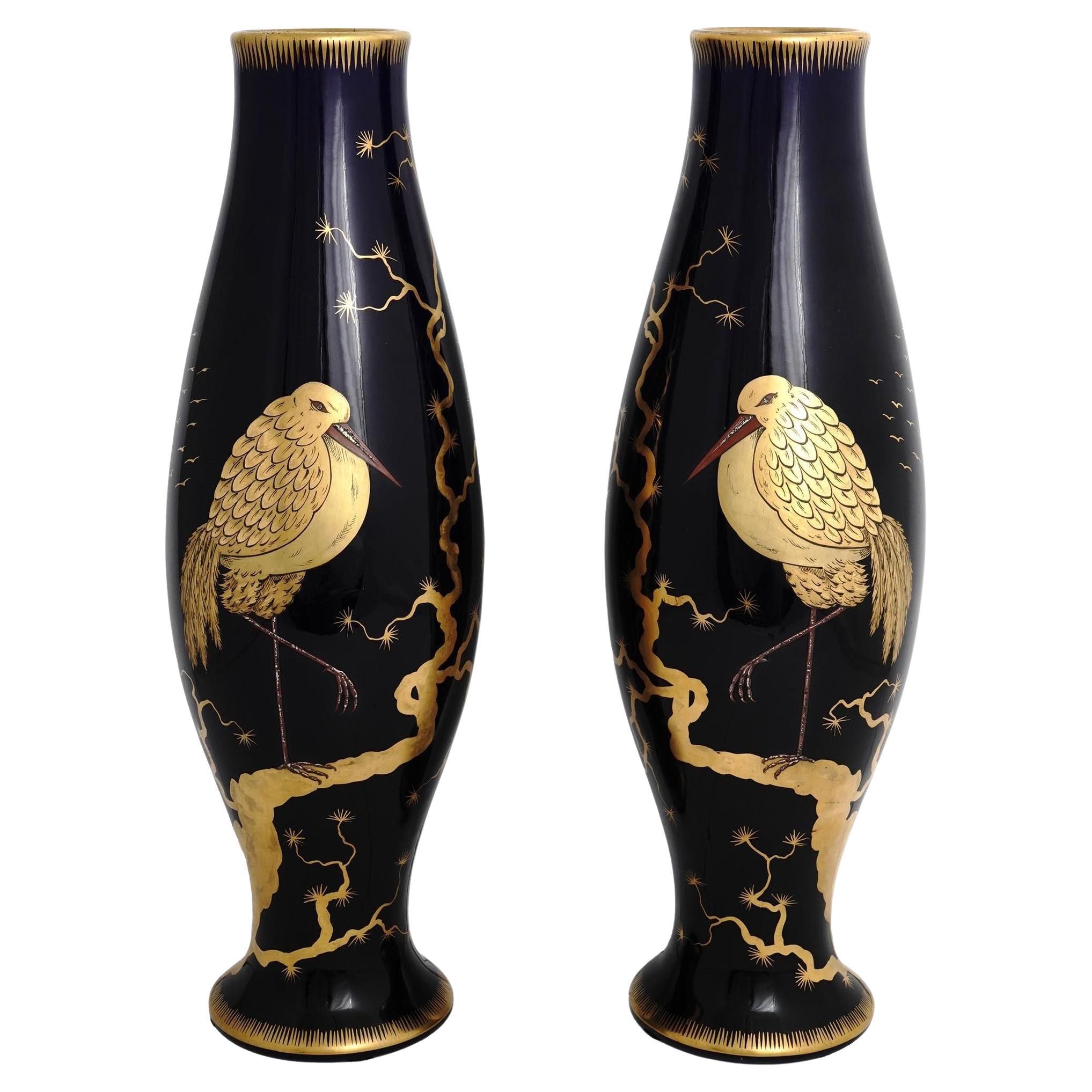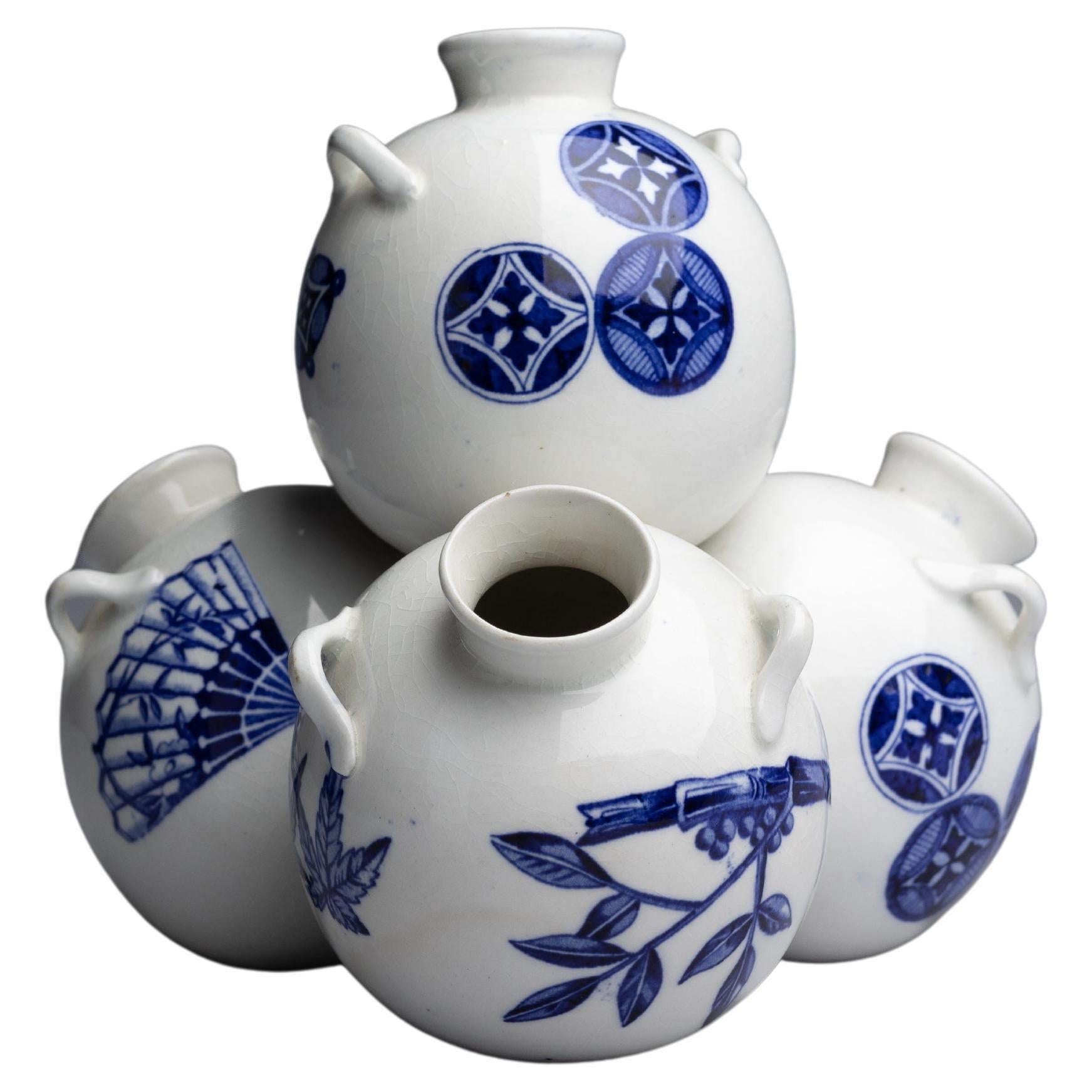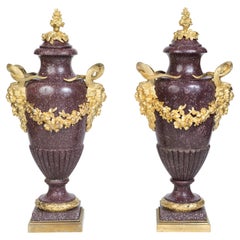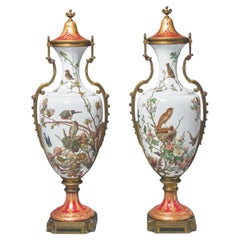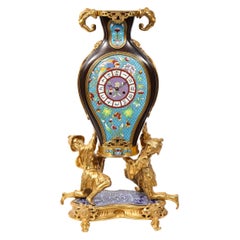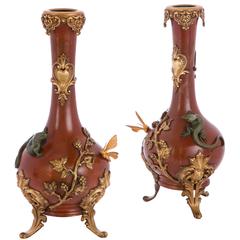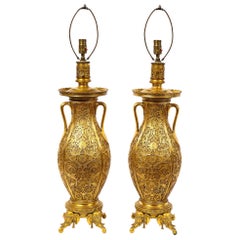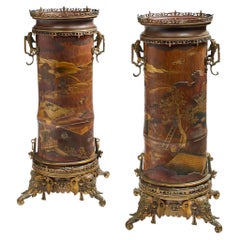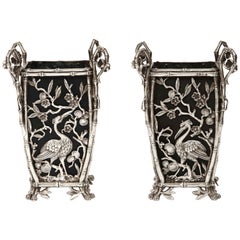
Pair of Unusual French Japonisme Silvered Bronze Planters Vases
View Similar Items
Want more images or videos?
Request additional images or videos from the seller
1 of 21
Pair of Unusual French Japonisme Silvered Bronze Planters Vases
About the Item
- Dimensions:Height: 12 in (30.48 cm)Width: 8 in (20.32 cm)Depth: 8 in (20.32 cm)
- Style:Japonisme (Of the Period)
- Materials and Techniques:
- Place of Origin:
- Period:
- Date of Manufacture:circa 1890
- Condition:
- Seller Location:New York, NY
- Reference Number:1stDibs: LU1798216692441
About the Seller
5.0
Vetted Seller
These experienced sellers undergo a comprehensive evaluation by our team of in-house experts.
Established in 1980
1stDibs seller since 2016
58 sales on 1stDibs
More From This SellerView All
- A Large Pair of French Ormolu-Mounted Porphyry VasesLocated in New York, NYElegance in Stone and Gilt: A Large Pair of French Ormolu-Mounted Egyptian Porphyry Vases, The gilt mounts 19th Century, the Porphyry, circa 1700's. Embark on a journey through time with this exceptional pair of Large French Ormolu-Mounted Egyptian Porphyry Vases – a harmonious union of history and artistry. The gilt mounts, crafted in the 19th century, pay homage to the opulence of the era while cradling the true treasures within – the Egyptian porphyry vases dating back to the 1700s. The porphyry, sourced from the enigmatic lands of Egypt, lends an air of ancient mystique to these majestic vases. Its rich, royal purple tones and intricate natural patterns echo the grandeur of ancient civilizations, infusing each piece with a palpable sense of history. The ormolu mounts, delicately worked and emblematic of 19th-century French craftsmanship, serve as a bridge between antiquity and the refined tastes of the Belle Époque. As you gaze upon these vases, you are invited to appreciate the confluence of two distinct epochs – the timeless allure of Egyptian antiquity...Category
Antique Early 19th Century French Neoclassical Vases
MaterialsPorphyry, Ormolu
- A Monumental "Exhibition" Pair Of Baccarat Opaline Glass Bronze Mounted VasesBy Cristalleries De BaccaratLocated in New York, NYAn Important and Monumental "Exhibition" Pair Of French Baccarat Opaline Opaque Glass Bronze Mounted Vases and Covers, Most Certainly Made For The Exposition Universelle of 1878. In...Category
Antique 19th Century French Napoleon III Vases
MaterialsBronze
- French Japonisme Ormolu, Patinated Bronze, and Cloisonne Enamel Mantel ClockBy Edouard Lievre, L'Escalier de CristalLocated in New York, NYA French Japonisme Chinoiserie Ormolu, patinated bronze, and cloisonne enamel mantel clock, Attributed to Escalier De Cristal and Edouard...Category
Antique Late 19th Century French Japonisme Mantel Clocks
MaterialsBronze, Enamel
- Monumental and Masterful Pair of French Paris Porcelain Hand-Painted VasesLocated in New York, NYA monumental and masterful pair of French Paris porcelain hand-painted vases, circa 1860. These museum quality vases are extremely fine quality....Category
Antique 19th Century French Rococo Vases
MaterialsPorcelain
- A Rare Pair of French Ormolu-Mounted Blue John Vases Candlesticks, C. 1870By Matthew BoultonLocated in New York, NYA Rare Pair of French Ormolu-Mounted Blue John Vases / Candlesticks, C. 1870, In the stye of Matthew Boulton. These rare and extremely elegant garnitu...Category
Antique 19th Century French Napoleon III Vases
MaterialsOrmolu
- Exceptional Pair of Vases by Louis Constant Sevin and Ferdinand BarbedienneBy Ferdinand BarbedienneLocated in New York, NYAn exceptional pair of French Ormolu and Champleve Enamel vases by Louis Constant Sevin and Ferdinand Barbedienne, circa 1860. "A Pair of Monumen...Category
Antique 19th Century French Napoleon III Vases
MaterialsBronze, Enamel
You May Also Like
- Pair of Lacquered and Gilt Bronze Antique Japonisme VasesLocated in London, GBWith an Arabesque rim and decorated with lizards, dragonflies and vines. These unusual vases reflect the European fascination Japan at the turn of the century and delightfully inco...Category
Early 20th Century French Japonisme Vases
MaterialsBronze
- Pair of French Japonisme Ormolu Vases E. Lièvre, Executed by F. BarbedienneBy Edouard Lievre, Ferdinand BarbedienneLocated in New York, NYAn important and monumental pair of very fine 19th century French Japonisme/Orientalist ormolu vases designed by Edouard Lièvre and Executed by Ferdinand Barbedienne. Each body with an oval shape, finely sculpted in a floral design, fringed by orientalist style handles with cartouches, the neck surmounted by a circular pierced scrolling dragon frieze. Each vase resting on a group of four orientalist style jeweled elephant...Category
Antique 1870s French Japonisme Vases
MaterialsBronze
- French 19th Century Pair of Lacquered Bamboos Japonisme VasesBy Ferdinand Barbedienne, Edouard LievreLocated in Saint-Ouen, FRA 19th French century pair of Lacquered Bamboos Japonisme vases. An amazing pair of tall cylindrical bamboo vases decorated in Japanese Gold and Sil-ver Hiramaki-E Lacquer with Pavilions in The Mist and Weaving Figures, Flown Over by a Pair of Cranes. Enclosed in a Sino-Japanese Inspiration Golden and Brown Patina Bronze Mount Featuring Elephant Heads, Partially Openwork Branches and Salamanders Forming Side Handles. Circa 1870 Attributed to Édouard Lièvre (1828-1886) and Ferdinand Barbedienne (1810-1892) Édouard Lièvre (1828-1886) is one of the most talented and prolific designer and industrialist of the 19th Century, his repertoire is sometimes Sino-Japanese or Neo-Renaissance, whether in furniture or works of art, we can note in particular the parade bed of Valtesse de La Bigne, furniture commissioned by the painter Édouard Detaille or even Sarah Bernhardt, and the famous works in collaboration with Maison Christofle or those in gilded bronze and cloisonné enamel edited by Ferdinand Barbedienne, presented at the Universal Exhibitions in 1878, 1889 and 1900. He was both a draftsman, painter, illustrator, engraver, ornamentalist and cabinetmaker, first trained in the studio of the painter Thomas Couture, Lièvre was then fully immersed in the world of decoration, creation and ornamentation and provides designs for manufacturers and merchant-publishers. Often assisted by his brother Justin, he first produced works of art for his own apartment, seeking out the finest craftsmen to execute his designs for bronzes, ceramics, fabrics and luxury furniture from great virtuosity and great taste. He then collaborated with the cabinet-maker Paul Sormani, as well as haberdasher merchants such as the Escalier de Cristal, bronziers such as Maison Marnyhac and especially Ferdinand Barbedienne as on our vases with bronze mounts characteristics of Edouard Lièvre's work. Born in 1810, died in Paris in 1892, Ferdinand Barbedienne, the most important caster of bronze pieces of art during the second half of the 19th Century, created and directed in Par-is one of the major artistic foundries of his time. Barbedienne specialized in classical reproductions, whose models were exposed in famous European museums. Their illustrated catalogues included many diverse objects such as busts, ornemental sculpture (clocks, candelabras, cups) sometimes even life-sized and bronzes for furniture. Apart from his own produc-tion, Barbedienne worked for the most renowned sculptors such as Barrias, Clésinger and Carrier-Belleuse. All his works were highly esteemed and he, himself honored by contemporary critics. At the London exhibition in 1851 Barbedienne’s firm won two « Council medals ». At the 1855 Universal Exhibition, he won a medal of honor. The success of Barbedienne’s firm brought him many official commissions, such in about 1860, as Barbedienne supplied bronzes for furniture for the Pompeian Villa of Prince Napoléon-Joseph, located avenue Montaigne in Paris. At the London Universal Exhibition of 1862 Barbedienne won medals in three different categories: Furniture, Silversmith work and Artistic bronzes. Barbedienne was made an officer of the Légion d’Honneur in 1867 and Commander in 1878 when he was compared with « a prince of industry and the king of bronze casting ». His glory did not decline with the passage of the time for at the Universal Exhibition of 1889 the critics thanked Barbedienne for the example he set for other bronze-casters by the perfection of his bronzes. “Japonisme” in the second half of the 19th century, was a craze for everything that came from Japan or imitated its style. The word was first coined in a series of articles published by Philippe Burty, from May 1872 to February 1873, in the French magazine “la Renaissance Littéraire et Artistique”. Far from the Academic sphere, artists seeking for new ways of expression, appropriated this discovery. Manet and the impressionists led the way to half a century of enthusiasm for Japanese art, and largely contributed to the esthetical revolution Europe experienced between 1860 and the beginning of the twentieth century. From 1862, The World’s Fairs provoked massive arrivals of fans, kimonos, lacquers, bronzes, silks, prints and books that launched the real era of Japonisme. With those exhibitions, the demand was boosted, the number of merchants and collectors was multiplied, and artists became passionate about this new esthetic. For them, its “primitivism” was probably its most important quality: artists were fond of the Japanese art’s capacity to be close to nature and to reconcile art and society by representing, with a lot of care, the most trivial objects. In painting, Edouard Manet, Mary Cassatt, Degas, Van Gogh, Gauguin were among those who were deeply inspired by Japanese art, affected by the lack of perspective and shadow, the flat areas of strong color, the compositional freedom in placing the subject off-center, with mostly low diagonal axes to the background. The Japanese iris, peonies, bamboos, kimonos, calligraphy, fish, butterflies and other insects, the blackbirds, cranes and wading birds, the cats, tigers, and dragons were endless sources of inspiration, appropriation, and reinterpretation for European artists. The occidental productions were combining styles and artistic conceptions instead of copying Japanese art slavishly. That is what brings to light the comparison between the artworks of Kitagawa Utamaro and Degas, of Katsushika Hokusai and Van Gogh The World’s Fairs of 1851 and 1862 in London, those of 1867, 1878, 1889 and 1900 in Paris, of 1873 in Vienna and of 1904 in Saint Louis presented a number of “Japanese-Chinese” installations with earthenware, bronzes, screens and paintings and attracted the largest amounts of visitors In Vienna, the “Japanese village...Category
Antique 1870s French Japonisme Vases
MaterialsBronze
- French Japonisme Ormolu-Mounted Baccarat Crystal Vase with Bronze Turtle FeetBy Cristalleries De BaccaratLocated in New York, NYA Gorgeous and extremely rare French Japonisme ormolu-mounted turtle footed Baccarat crystal vase designed with a gilt turtle design, Baccarat stamp on bottom. The quality and craftsmanship of this piece is second to none. Baccarat crystal is known to be the best crystal in the world and this piece appropriately demonstrates that. The crystal vase is seated on four beautifully cast and hand-chiseled ormolu turtles, representing the Japanese artistic movement in France at the time, known as 'Japonisme'. The body of the vase is a gorgeously hand painted with raised gold and enamel decoration of a turtle and various other decorations, making it seem as though the turtle is swimming in a lake. Underneath the turtle are painted rocks and mosses, while above the turtle are cherry trees, dropping their fruit into the water. On the reverse of the main panel are two turtles swimming...Category
Antique 1880s French Japonisme Vases
MaterialsCrystal, Bronze
- Unusual French Japonisme Ormolu-Mounted Tole Jardinière, circa 1870Located in New York, NYUnusual French Japonisme ormolu-mounted tole jardinière, circa 1870. Very nice and unusual rectangular jardinière / planter made from the best quality ormolu. Designed with flower...Category
Antique 19th Century French Japonisme Vases
MaterialsOrmolu
- Antique Japonisme French Baccarat Glass Bronze VaseBy BaccaratLocated in New York, NYAn antique French Baccarat glass vase with a fluted mouth. The vase is adorned with hand painted floral and foliage motifs in the Asian man...Category
Antique 19th Century French Vases
MaterialsBronze
Recently Viewed
View AllMore Ways To Browse
Pair Bronze Cranes
Pair Of Bronze Cranes
Silvered Bronze Jardiniere
Crane Bronze Vase
French White Pot
French Ceramic Pots
Antique Chinese Jardiniere
Cache Pot
Cache Pots
Cacher Pot
Cachepot With Flowers
Jardiniere Planter Gilt
Ceramic Pots Planters
White Cachepots
Antique Porcelain Planter
Antique Porcelain Planters
French Bronze Jardiniere
Antique French Majolica Vases

